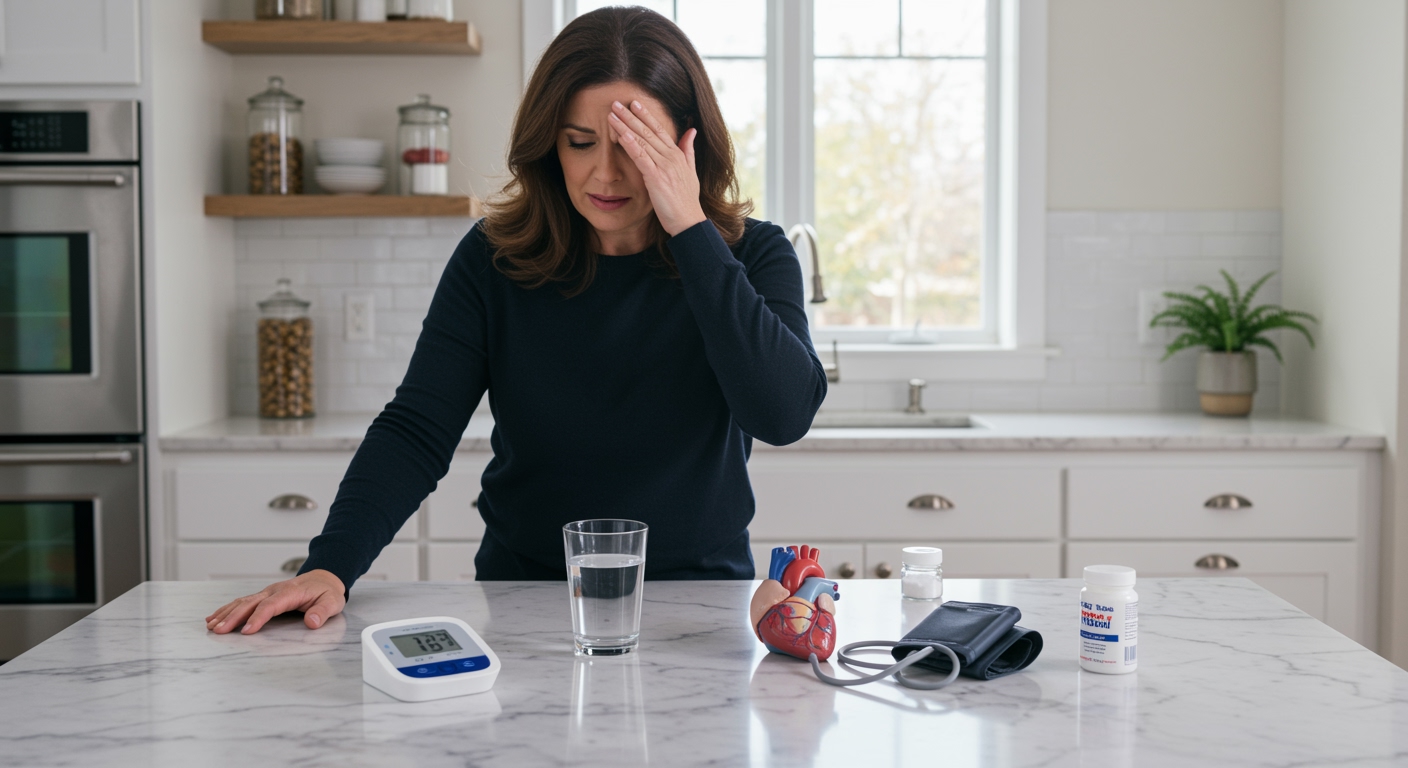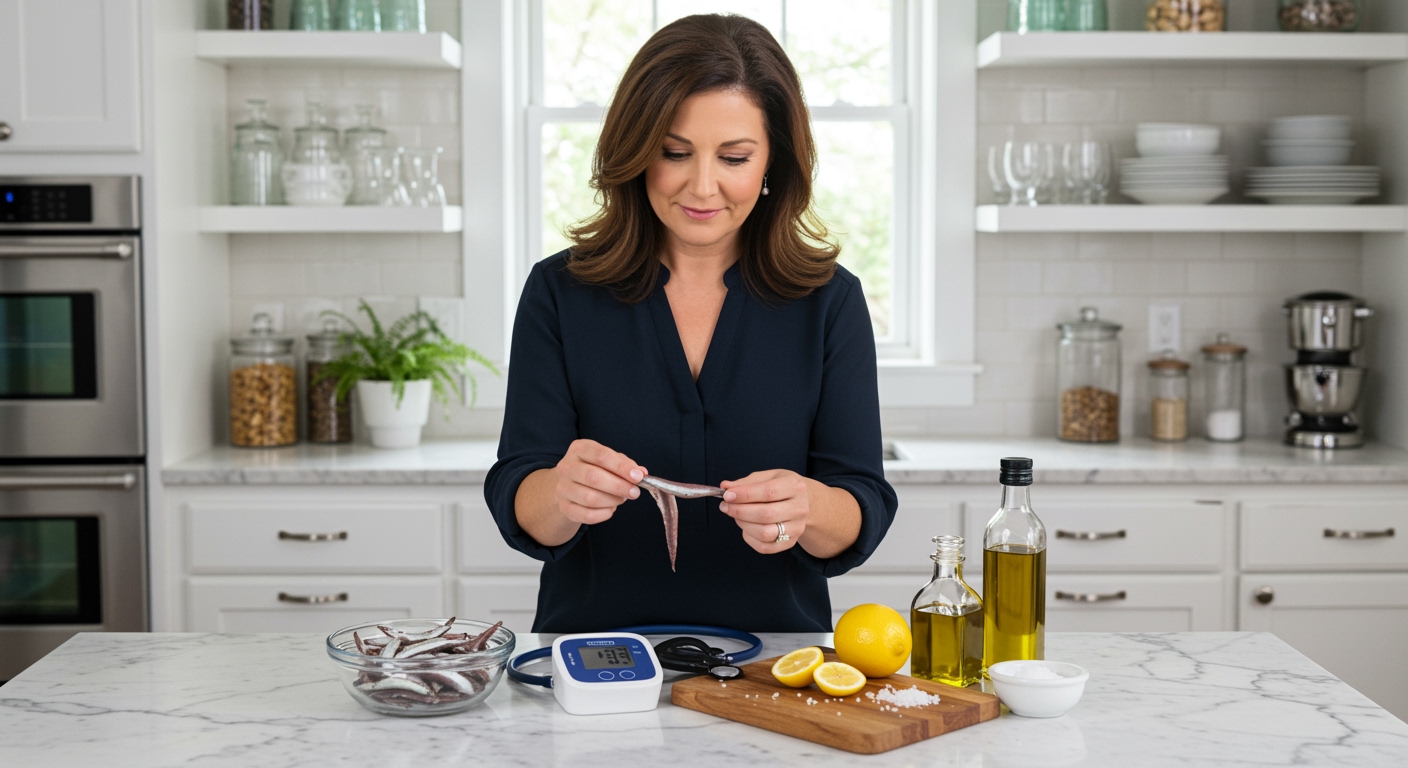✪ Key Takeaway: Standing up quickly can worsen low blood pressure by causing orthostatic hypotension, leading to dizziness and fainting.
Introduction
You jump up from your chair and suddenly the world starts spinning.
Your vision goes dark for a moment and you feel like you might fall over. This happens because standing up quickly can make your already low blood pressure drop even further, creating a dangerous situation that affects millions of people worldwide.
Hi, I’m Abdur, your nutrition coach and today I’m going to explain exactly how standing up affects your low blood pressure and what you can do to prevent these scary episodes.
What Happens When You Stand Up Too Fast?
When you stand up quickly, gravity pulls about 500 to 700 milliliters of blood down toward your legs and pelvis.
This sudden shift means less blood returns to your heart, which reduces the amount of blood your heart can pump out. Your blood pressure drops instantly because there is simply less blood circulating through your upper body and brain.
Normally, your body has built-in mechanisms to handle this challenge. Special sensors called baroreceptors in your neck and chest detect the pressure drop within seconds.
These sensors send urgent signals to your brain, which responds by increasing your heart rate and tightening blood vessels. This process usually happens so fast that you never notice any symptoms.
However, when you already have low blood pressure, this compensation system becomes overwhelmed. Your body cannot respond quickly enough or strongly enough to prevent the dangerous drop in blood flow to your brain.
The result is orthostatic hypotension, a condition where your blood pressure falls significantly when you change from lying or sitting to standing. This can cause dizziness, lightheadedness, blurred vision, weakness, and even fainting.
✪ Fact: Your blood pressure can drop by 20 mmHg systolic or 10 mmHg diastolic within three minutes of standing.
Why Does Low Blood Pressure Make This Worse?
People with low blood pressure start from a disadvantaged position when they stand up.
While someone with normal blood pressure might drop from 120/80 to 100/70 and still feel fine, someone starting at 90/60 could drop to 70/50 or lower. This puts them in a dangerous zone where their brain and organs do not receive adequate blood flow.
Your brain needs a constant supply of oxygen and nutrients carried by blood to function properly. When blood pressure drops too low, your brain essentially goes into emergency mode to protect itself.
The symptoms you experience are actually your brain’s way of forcing you to lie down or sit down. Dizziness and weakness make it difficult to remain standing, which helps restore blood flow to your brain through gravity.
Some people with chronic low blood pressure develop a condition called neurally mediated hypotension. In this condition, the nervous system actually works against itself, causing blood vessels to widen and heart rate to slow down when standing up.
This creates a vicious cycle where standing up triggers an inappropriate response that makes blood pressure drop even further. The more severe your baseline low blood pressure, the more likely you are to experience these problematic episodes when changing positions.
✪ Pro Tip: Stand up slowly and pause halfway to give your cardiovascular system time to adjust.
What Are The Warning Signs To Watch For?
The symptoms of orthostatic hypotension can range from mild to life-threatening.
Early warning signs include feeling lightheaded or dizzy when you first stand up. You might notice that your vision becomes blurry or you see spots or stars for a few seconds.
Some people experience a feeling of weakness in their legs or a sense that they might fall over. Your heart might start racing as it tries to compensate for the blood pressure drop.
More serious symptoms include nausea, sweating, and confusion. These indicate that your brain is not getting enough oxygen and blood flow.
The most dangerous symptom is fainting or near-fainting episodes. When you faint, your body is essentially forcing you into a horizontal position to restore blood flow to your brain. However, falling can cause serious injuries, especially in older adults.
Some people develop chest pain or shortness of breath when standing up quickly. This happens because your heart is working overtime to try to maintain adequate blood pressure and circulation.
Pay attention to when these symptoms occur most frequently. Many people notice they are worse in the morning after lying down all night, during hot weather, or after eating large meals when blood flow is diverted to the digestive system.
✪ Note: Symptoms lasting more than a few minutes after standing require immediate medical attention.
How Can You Prevent These Episodes?
The most effective prevention strategy is changing your movement patterns throughout the day.
Instead of jumping up quickly, practice the three-stage standing technique. First, sit up slowly and pause for 10 to 15 seconds. Then move to the edge of your seat and pause again. Finally, stand up gradually while holding onto something stable for support.
Staying properly hydrated is crucial because dehydration makes orthostatic hypotension much worse. Aim for at least 8 glasses of water throughout the day, and increase this amount during hot weather or when you are sick.
Compression stockings can help prevent blood from pooling in your legs when you stand up. These special socks apply gentle pressure that helps push blood back up toward your heart and brain.
Increasing your salt intake slightly can help raise your blood pressure, but this should only be done under medical supervision. Too much salt can cause other health problems, so work with your doctor to find the right balance.
Avoid standing for long periods, especially in hot environments. If you must stand for extended times, try shifting your weight from one foot to the other or doing calf raises to keep blood moving.
Be extra careful when getting out of bed in the morning. Your blood pressure is naturally lower after lying down all night, so take your time and consider sitting on the edge of the bed for a minute before standing.
✪ Pro Tip: Keep a glass of water by your bed and drink it before standing up in the morning.
When Should You See A Doctor?
You should seek medical attention if you experience frequent episodes of dizziness or fainting when standing up, especially if these episodes are getting worse over time.
Any episode that results in a fall or injury requires immediate medical evaluation. Falls can cause serious complications, particularly head injuries or broken bones.
If you experience chest pain, severe shortness of breath, or confusion along with the dizziness, these could be signs of a more serious underlying condition that needs urgent treatment.
Your doctor can perform simple tests to diagnose orthostatic hypotension. They will measure your blood pressure while you are lying down, sitting, and standing to see how much it drops with position changes.
Sometimes orthostatic hypotension is caused by medications, dehydration, or underlying health conditions like diabetes or heart problems. Identifying and treating these root causes can significantly improve your symptoms.
Your healthcare provider might recommend specific medications that can help raise your blood pressure or improve your body’s ability to respond to position changes. These treatments can be very effective when used properly.
✪ Fact: Orthostatic hypotension affects up to 20% of people over age 65 and can increase fall risk significantly.
The Bottom Line
Standing up quickly can definitely worsen low blood pressure by causing orthostatic hypotension, which leads to dangerous drops in blood flow to your brain and other vital organs.
Your body is not broken, it just needs more time and support to handle position changes safely. By understanding how your cardiovascular system responds to standing up and implementing simple prevention strategies, you can significantly reduce your risk of experiencing these frightening episodes.
Remember that managing low blood pressure and orthostatic hypotension is an ongoing process that may require adjustments over time. I would love to hear about your experiences with these symptoms or any questions you might have about managing low blood pressure in the comments below.
References
At NutritionCrown, we use quality and credible sources to ensure our content is accurate and trustworthy. Below are the sources referenced in creating this article:
- American Heart Association: Feel dizzy when you stand up? It’s a drop in blood pressure
- Mayo Clinic: Orthostatic hypotension diagnosis and treatment
- Harvard Health: When blood pressure falls after you stand up
- National Center for Biotechnology Information: Orthostatic hypotension research





